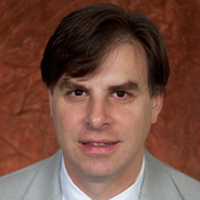
professor in the College of
Medicine's Department of
Biomedical Sciences.
In the second part of his lab’s recent one-two punch, Florida State University researcher Daniel Kaplan said he has solved a cell division mystery in a way that will intrigue the makers of cancer-fighting drugs.
The key, said Kaplan, a College of Medicine Department of Biomedical Sciences researcher, is a protein called Treslin.
“It can target cancer cells,” he said. “Most chemotherapy also targets rapidly dividing normal cells, but this seems to have promise for not doing that. Drug companies are going to be excited.”
Before cells can divide, their DNA must be copied. In addition, the strands of the DNA’s famous double helix must be unwound, via a protein called helicase. One strand needs to be inside the helicase ring, the other outside. As Kaplan’s lab reported last year in the Journal of Biological Chemistry, a kinase — that is, a protein that chemically modifies other proteins — called Cdc7 opens up the helicase ring to let one strand out.
But not until this summer, in a paper published in Proceedings of the National Academy of Sciences, did Kaplan and Research Faculty Irina Bruck figure out that Treslin was also a key ingredient — in two ways.
“We had tried to reconstitute the chemical modification step in our lab,” Kaplan said, “but we always had a weak reaction. Dozens of other labs published this kind of work, and it was always weak. Always in the back of my mind I was saying, ‘Maybe something’s missing.’ It occurred to me that there must be some kind of activator. So we started trying different proteins.”
Eventually they singled out Treslin. (It’s called Sld3 in budding yeast, which their lab and others often use because the cells are similar to humans’ but grow much faster.) Treslin not only stimulates the chemical modification of the helicase, thereby activating it, but also assembles the helicase in preparation for cell division. Since cancer is the unregulated division of cells, knowing how to stop the division process is crucial to halting cancer.
“We think this is really important,” Kaplan said, “because now we can take this purified Treslin and the helicase, put them in a tube and watch the chemical modification occur. Then we can add small molecule inhibitors to see if we can inhibit that. That should stop activation of the helicase. That should stop the cancer cells from dividing. You kill cancer cells but not normal cells.”
Florida State has filed a provisional patent. It has a year to find a drug company interested in partnering to develop a small molecule inhibitor.
“Dr. Kaplan continues to make important and innovative advances in our understanding of the mechanisms of DNA replication control,” said researcher Tim Megraw, also on the Biomedical Sciences faculty. “His new findings reveal the novel functions of Treslin to regulate the DNA helicase, a key macromolecular machine that controls DNA replication. This latest discovery is very exciting.”
Kaplan finds the work fascinating.
“Evolution has done such a good job of producing molecules to perform these exquisitely, highly regulated chemical reactions,” he said. “It’s just a big bucket of chemistry in a cell, and it’s very precisely regulated and orchestrated. We now know that Treslin is kind of a conductor.”
But how does that one DNA strand actually come outside the helicase ring before cell division? What stabilizes it once it’s out? What causes the ring to close again? For Kaplan and Bruck, seeking those answers is the next step.




